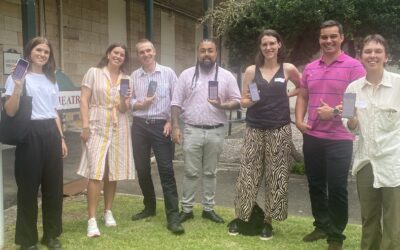Effective orientation and handover becomes increasingly important as junior doctors are faced with patients with more complex, multiple comorbidities, rising service demands because of workforce shortages, and a growing need to teach undergraduates as they move through the system (1).
The need to upskill within a new environment by learning site specific procedures, understand the ‘way things are done’, and deliver a quality care experience is never easy – particularly for a JMO or graduate nurse.
Large enterprise technology systems used by hospitals are typically unwieldy, difficult to navigate, and plagued by roadblocks to critical information (2). It’s not surprising then that within the complexity, opportunities abound for things to go wrong.
Just think about any given day within a hospital.
A clinician – irrespective of whether they’re a doctor, nurse or allied health professional – undertakes multiple tasks using countless pieces of equipment and interacts with a growing number of technology solutions. Commencing a new rotation, or coming into a hospital as a locum or agency staff member (for example, to meet increased need created by COVID-19), it is challenging to gain sufficient knowledge and fluency in systems and procedures to ensure errors are avoided. Add to this mix, the distractions and interruptions common to a regular day in clinical life, and the stage is set perfectly for vulnerability to mistakes and compromised clinician wellbeing.
In terms of volume of information alone, communication is key. Yet most hospital systems – despite best intentions – struggle to support clinicians to gain a rapid understanding of critical information about new roles and responsibilities, as well as other valuable guidance for handover, protocols, or prescribing.
The net effects are far reaching.
Experience, feedback, and research tells us that clinical orientation falls well short of the optimal experience it should be (1). Confusion is common and highly disconcerting. Clinician wellbeing is impacted significantly as confidence is eroded (3). Engagement falls away too, contributing to a downward spiral characterised by cynicism and a resignation that challenges hospital management and administrators to develop solutions that address specific needs.
Although integration of technology has improved many aspects of hospital administration, it has not solved the problem of information overload and poor access to critical information that faces any training clinician who works in a hospital (2).
Technology’s role in a hospital
No doubt the search for hospital performance improvement continues from many angles and now more than ever, technology innovation plays an integral role to ease the burden. Particularly where the solution supports healthcare professionals to deliver the same or better patient outcomes.
Where an existing system or process isn’t working – say, in the dissemination of critical information to clinicians (e.g. correct PPE procedures) – there is an opportunity to review and rethink these, and if appropriate, adopt technology that simplifies the timely exchange of information. If getting the right information in the hands of users is the goal, then few would question this logic.
However, technology for the sake of it, does not solve all problems. Large IT implementation projects in healthcare have proven that (2).
Rather, improvements realised through technology should enhance system efficiency. In the case of JMO orientation – it ought to address the challenge of information overload that stalls the delivery of healthcare and leads to costly clinical, operational, and financial mistakes.
The good news is that implementation of technology in Australian, New Zealand and UK hospitals are showing success with an online/offline resource that aggregates clinical information works. Feedback, usage reports, and time in motions studies show that efficient data management within systems improves productivity and supports clinicians to make better informed decisions (4).
Other benefits accrue to the hospital system too. Apart from saving time, increased patient/doctor contact leads to better patient satisfaction (5). Removal of paper manuals and guidelines reduces printing costs and environmental impact. Real time audit trails and sign-offs streamline hospital accreditation, reporting, and audit processes. Also, the power of a team member’s personal device, either a smartphone or tablet, decreases dependency on desktop computers and IT infrastructure.
What about COVID and the case for simplifying the complicated systems?
Although the issues for any cohort of JMO have been longstanding, the COVID-19 pandemic has placed the spotlight firmly on the imperative to rethink the orientation of training clinicians. Undoubtedly, this will continue beyond COVID, as it calls for a transformation within broader, complicated hospital systems that makes the use of digital tools a necessity (6).
The ‘new normal’ demands all stakeholders have easy access to aggregated vital information, regardless of time and place, including within the context of social distancing. This is already being achieved in hospitals via an app downloaded to clinicians’ smartphones . Not only does this support a more engaging orientation experience, it addresses the other significant challenges presented by a complicated hospital system – and now, COVID.
Allowing vital clinical and organisational information to be curated in a single location, digital tools like Med App also help prevent physician burnout characteristic of a typical clinician training experience (7).
COVID has added to the intensity of the healthcare working environment for all, making it even more important for colleagues to look out for each other and make time to ask, R U Okay?.
Med App helps with this too.
Access to wellbeing resources at the fingertips of clinicians provides the tools needed to manage potentially stressful situations and adjust to new roles and responsibilities with greater ease. Giving support like this to training clinicians, such as junior doctors or graduate nurses, reduces stress and ultimately leads to delivery of better patient care (7).
And surely, that’s the ultimate objective.
The JMO orientation experience within a complicated hospital system can be vastly improved with the right technology, implementation, and support. As the COVID crisis continues, there has never been a more important time to review outdated information sharing processes within healthcare. The Med App team can support organisations like yours with its offline-accessible, mobile first tool designed to simplify access to clinical and hospital guidelines, clinician communication, and employee education and training. Learn more about Med App or book a demonstration with our team.
- Mulroy, Seonaid, et al. “What do junior doctors want in start‐of‐term orientation?.” Medical journal of Australia 186.S7 (2007): S37-S39.
- Cresswell, Kathrin M., and Aziz Sheikh. “Health information technology in hospitals: current issues and future trends.” Future Hospital Journal 2.1 (2015): 50.
- Markwell, Alexandra L., and Zoe Wainer. “The health and wellbeing of junior doctors: insights from a national survey.” Medical Journal of Australia 191.8 (2009): 441-444.
- Internal data – unpublished
- Ha, Jennifer Fong, and Nancy Longnecker. “Doctor-patient communication: a review.” Ochsner Journal 10.1 (2010): 38-43.
- Keesara, Sirina, Andrea Jonas, and Kevin Schulman. “Covid-19 and health care’s digital revolution.” New England Journal of Medicine 382.23 (2020): e82.
- Davis, Matthew J. “Using Technology to Combat Clinician Burnout.” Journal of Healthcare Management 65.4 (2020): 265-272.





0 Comments